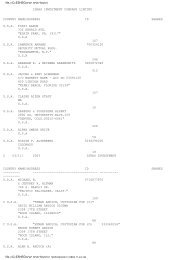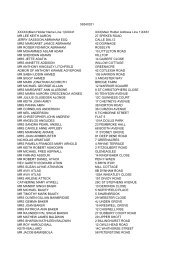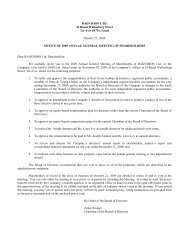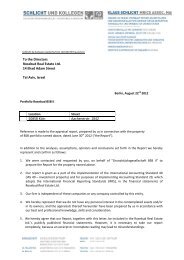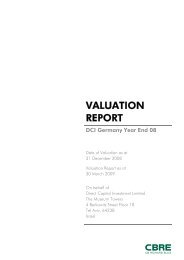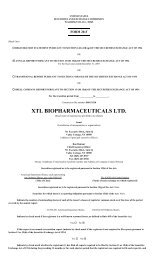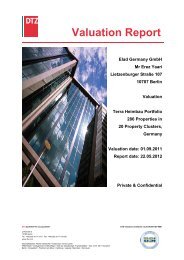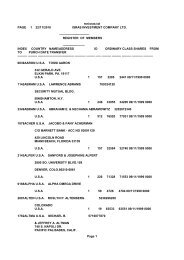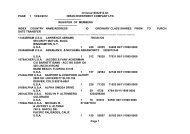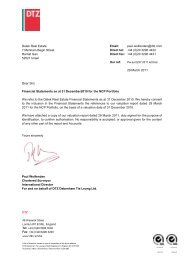RETALIX LTD.
RETALIX LTD.
RETALIX LTD.
Create successful ePaper yourself
Turn your PDF publications into a flip-book with our unique Google optimized e-Paper software.
Our Market Opportunity<br />
The customer retention battle<br />
The retail food and fuel industries today are characterized by intense competition, resulting in increased pricing pressure and narrowing operating<br />
margins. Retailers are losing customers to their larger competitors that offer aggressive pricing as well as greater shopping convenience and superior<br />
customer service. The largest retailers, such as WalMart, are increasingly using their size and scale to realize cost savings and operating efficiencies from<br />
their supply chain, which they then pass on to the consumer in the form of lower prices. This trend creates an industry dynamic whereby more and more<br />
consumers are attracted to these price-cutting retailers, thus accelerating these retailers’ revenue growth and allowing them to further increase their<br />
economies of scale. The distributors that supply many of these retailers are facing the same market trends, as they are asked to become more efficient, to<br />
offer better products at lower costs, to consolidate services, to provide visibility into the supply chain and to facilitate the competitive capabilities of their<br />
customers – the retailers.<br />
At the same time, large food retailers and distributors are expanding their operations beyond their traditional focus on food supermarkets to<br />
encompass additional retail formats, such as convenience stores, food service, fuel stations and quick service restaurants, or QSRs. This has increased the<br />
competition in the convenience store market sector, which historically has been served by smaller chains and independent retailers. These small and<br />
independent operators are finding it increasingly difficult to compete effectively with the aggressive pricing and associated lower margins resulting from<br />
increasing competition. Similarly, competition has reduced margins at the fuel pump, causing large fuel retailers to add convenience store and QSR,<br />
formats in an effort to increase their overall margins. This has further increased competition in the convenience store and fuel station market sectors, which<br />
in turn favors the large retailers and distributors that can leverage their size and scale to realize operating efficiencies in their supply chain, thereby<br />
lowering their cost base and allowing them to deliver lower prices.<br />
One of the primary factors that allows such large retailers and distributors to realize supply chain operating efficiencies is their use of sophisticated<br />
retail information systems, often developed in-house, that provide them with comprehensive visibility into their extended supply chain. Armed with such<br />
visibility, these retailers and distributors can more efficiently execute and track all of their supply chain tasks, such as order optimization, inventory<br />
management, merchandising and pricebook management. In addition, this supply chain visibility also allows retailers to optimize their pricing and<br />
promotion decisions in order to increase demand and sales.<br />
The information system needs of food and fuel retailers and distributors<br />
In order to compete more effectively, food and fuel retailers and distributors need retail information systems comparable to those used by the largest<br />
food retailers, distributors and major fuel chains in order to be able to realize additional operating efficiencies from their supply chains. In particular,<br />
retailers and distributors require robust retail information systems that can:<br />
increase operating efficiencies through tighter integration of in-store, enterprise level and warehouse management systems, enabling visibility<br />
across the entire scope of their retail and distribution operations;<br />
capture and analyze data and leverage customers’ demand information to enable advanced forecasting capability and thereby to optimize the<br />
ordering and inventory stocking process in the store and in distribution centers; and<br />
extend supply chain visibility to include suppliers and customers, enabling retailers and distributors to share data and collaborate between<br />
themselves and with suppliers in supply chain decisions.<br />
However, in order to deter customers from shifting their patronage to the largest chains, smaller retailers and distributors require more than increased<br />
operating efficiencies and competitive pricing. In order to compete effectively with these larger chains, smaller retailers need to provide consumers with an<br />
improved shopping experience through diverse retail formats and better customer service and to incentivize their customer base to increase their patronage<br />
of their stores through customer loyalty and other promotion strategies. As a result, in an effort to increase customer retention and influence customer<br />
spending habits, retailers and distributors are increasingly seeking information systems that can, in addition to achieving operating efficiencies, also:<br />
19



